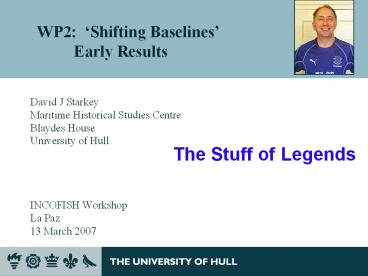WP2: PowerPoint PPT Presentation
1 / 18
Title: WP2:
1
WP2 Shifting Baselines Early Results
- David J Starkey
- Maritime Historical Studies Centre
- Blaydes House
- University of Hull
- INCOFISH Workshop
- La Paz
- 13 March 2007
The Stuff of Legends
2
Structure of Presentation
- Publications
- 2. Validation of Source Material
- 3. Valid Data to Online Resource
3
1. Publications
- 1 paper published
- 1 paper accepted
- 15 submitted, including 13 for special issue
Fisheries Research - 7 papers in preparation
- 2 scholarly websites
4
Published Paper
- John K Pinnegar, Trevor Hutton Vicenzo
Placenti - What relative seafood prices can tell us
about the status of stocks - Fish and Fisheries, 2006, 7, 219-26
- CEFAS Scientific Paper of the Year
- 500 Prize!
5
- Accepted for publication in 2007
- John K Pinnegar Georg H Engelhard
- The shifting baseline phenomenon a global
perspective - Reviews in Fish Biology Fisheries
7 papers in preparation 15 papers in review,
including . . .
6
Fisheries Research - special INCOFISH/HMAP
issue(Henn Ojaveer B.R. MacKenzie, eds)
- Poulsen, R., Cooper, A.,Holm, P. The importance
of historical baselines to fisheries management -
an abundance estimate of ling (Molvamolva) and
cod (Gadus morhua) the northeastern North Sea,
1872 - Poulsen, B., Holm, P. A fishery of historical
magnitude. Reconstructing the 17th-19th centuries
catches of herring, eel, whitefish and plaice in
Limfjorden, Denmark - Bager, M., Søndergaard, M. K. The Danish Baltic
Sea fisheries c. 1875-1911 - MacKenzie, B. R., Myers, R. A. The development
of the northern European fishery for north
Atlantic bluefin tuna (Thunnus thynnus) during
1900-1950 - Eero, M., MacKenzie, B. R., Karlsdottir, H.
Dynamics of international fisheries for cod
(Gadus Gaumiga, R.morhua) in the eastern Baltic
Sea during 1880-1938 - Enghoff, I. B., MacKenzie, B. R. Nielsen, E. E.
The Danish fish fauna during the warm Atlantic
period (ca. 7000 - 3900 BC) forerunner of future
changes?
7
Fisheries Research (special issue), continued
- Lotze, H. Rise and fall of fishing and marine
resource use in the Wadden Sea, southern North
Sea - Gaumiga, R., Karlsons, G., Uzars, D. Gulf of
Riga (Baltic Sea) fisheries in the late 17th
century - Ojaveer, H. Lajus, J., Ojaveer, H., Tammiksaar,
E. Fishing in the NE Baltic during the 19th
century what can be learned from the archives of
Karl Ernst von Baer? - Lajus, D., Alekseeva, Y., Lajus, J. Herring
fisheries in the White and Barents Sea in the
18th - beginning of the 20th cc factors
effecting the catch fluctuations - Lajus, D., Dmitrieva, Z., Kraikovski, Lajus, J.,
Yurchenko, A., Alexandrov D. Historical records
of the 17 18th century fisheries for Atlantic
salmon in northern Russia methodology and case
studies of population dynamics - Lajus, J., Kraikovski, A., Lajus, D. Coastal
fisheries in the Gulf of Finland basin in the
15-20th centuries on the base of Russian
historical sources - Ojaveer, H., Awebro, K., Karlsdottir, H.
MacKenzie, B. Swedish Baltic Sea fisheries
during c. 1870-1913 spatio-temporal dynamics of
catch and fishing effort
8
2. Validation of Source Material
- Primary Sources
- archaeological, paleo-ecological, material
culture, history on the ground, oral testimony,
documents - Methodology
- the means by which raw data is transformed into
valid evidence - Source Assessment Validation
- provenance corroboration context meaning
9
Provenance when how was source generated? by
whom? for what purpose? is it complete?
- Corroboration
- are the data supported by other sources?
- do they concur?
- yes - implies reliability/accuracy
10
Context knowledge of the relevant time
space empathy with the data generators typicali
ty of cases
Meaning meaning of language significance of
data
For example . . .
11
David J. Starkey British Privateering Enterprise
in the 18th Century
Composition of British Privateering Fleet,
1689-1815 8 wars 10,400 vessels 72
ports Peak - Feb 1781 (19,632 men)
expeditions deep-water
channel
12
Channel Privateers
South East England
South West England
Jersey Guernsey
Cruising Grounds English Channel Bay of
Biscay (inshore)
13
Deep-Water Private Ships-of-War
Marquise d'Antin and Louis Erasme taken by the
Duke and Prince Frederick 10 July 1745
14
Privateering Expeditions
Cinque Ports Gally ( 260 tons) St George (130
tons) William Dampier 1703-1706
Success (350 tons) Speedwell (350 tons) George
Shelvocke 1718-1720
Duke (350 tons) Dutchess (300 tons) Woodes
Rogers 1708-1711
15
Gulf of California
La Paz
16
Edward Cooke, A Voyage to the South Sea and
Round the World in the Years 1708 to 1711 (1712)
George Shelvocke, A Voyage Round the World by the
way of the Great South Sea (1726)
17
Privateers and Marine Science
privateers or buccaneers had two main reasons
to frequent the Gulf of California. The first
was that for the entire 18th century this
enclosed sea offered several good harbours,
almost unvisited by Spaniards, where captains
could careen their ships or get protection from
nasty weather (Gerhard 1963). The second reason
was due to Thomas Cavendishs successful
enterprise in the late 1580s in capturing the
Manila boat, a Spanish vessel that each year
carried gold, jewels and other wealth between
Manila and Acapulco. By the 17th century this
enterprise had become a legend among English
seamen Rogers 1711 (1970).
Andrea Saenz-Arroyo, The Value of Evidence
about Past Abundance Fish and Fisheries, 7
(2006), 128-46
18
Pirates frequently made detailed journals of
their expeditions in distant oceans. On returning
home, the epic accounts of their trips were
warmly welcomed by the publishers. Examples
include books by Thomas Cavendish, Woodes Rogers,
William Dampier, Edward Cooke and George
Shelvocke. Some buccaneers left important
descriptions not just of the natural world, but
of the culture of the inhabitants they
encountered (Fig. 2). Among them are diaries from
Woodes Rogers and his companions at the beginning
of the 18th century Dampier 1697 (1968) Rogers
1711 (1970) Cooke 1712 (1969) and George
Shelvockes journal published in 1726 Shelvocke
1726 (1928).
Andrea Saenz-Arroyo, The Value of Evidence
about Past Abundance Fish and Fisheries, 7
(2006), 128-46

